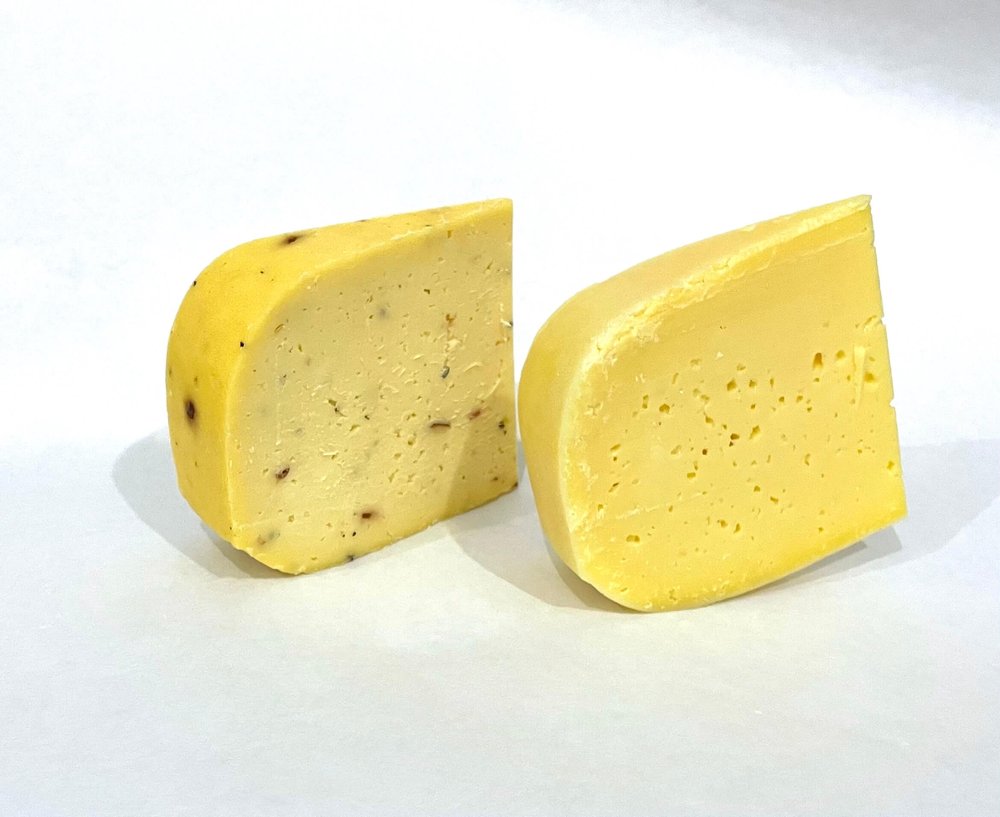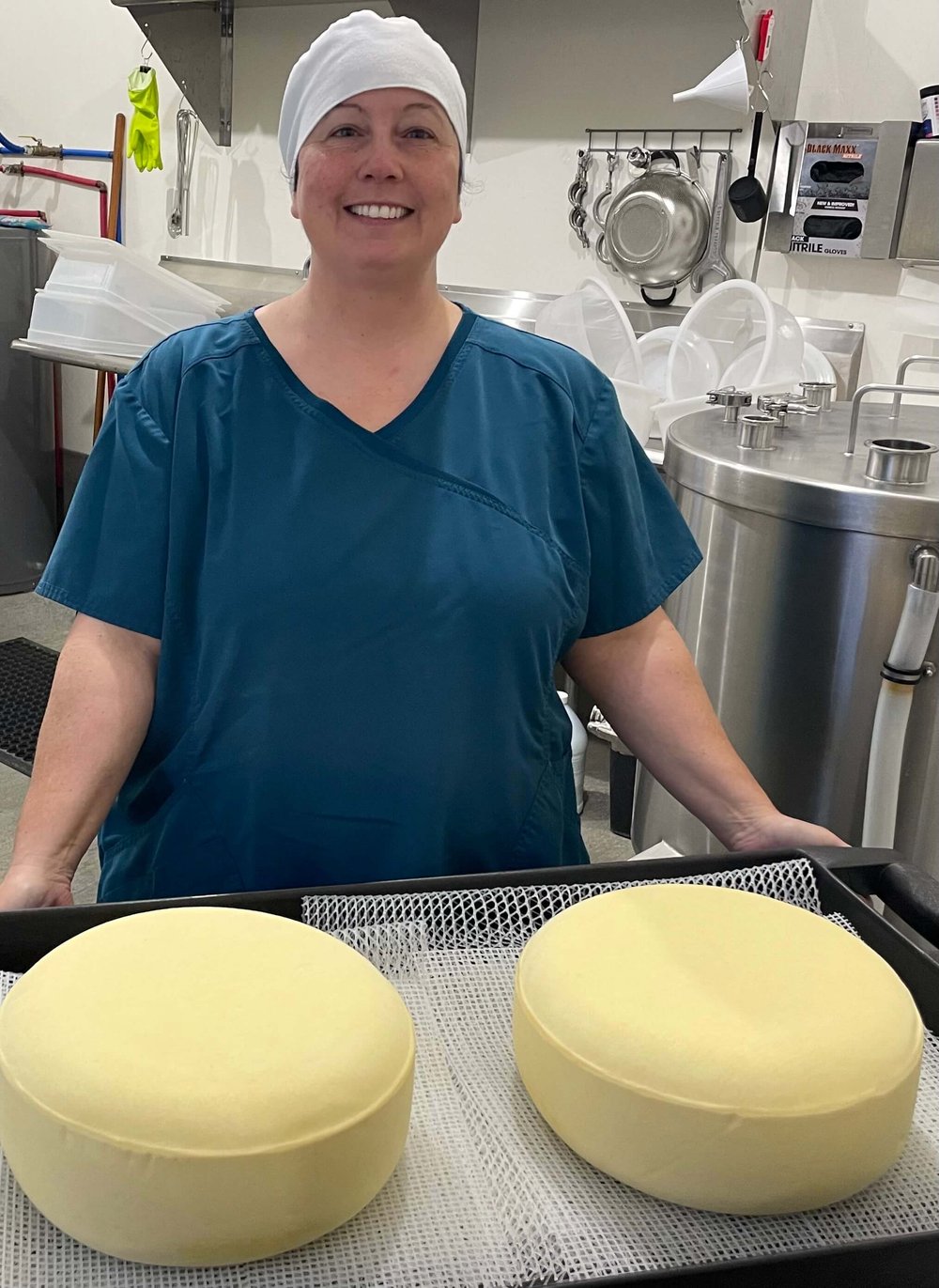Regenerative agriculture is a system that restores soil and ecosystem health to improve land, water, and help reverse climate change. Dairy farmers Stacy and Virginia Thomas did not even know they had applied regenerative agricultural practices at their Clover Mountain Dairy in Chewelah, Washington until someone pointed it out to them. Now, they are spreading the word to other dairies and farmers that regenerative agricultural practices can work to make a farm in balance.
First Generation Farmers
Riecker Mountain pepper jack and young gouda Tamarack photo credit Clover Mountain Dairy
The Thomases describe themselves as “Dairy farmers who happen to make cheese.” When asked what drew them into the world of dairies, Stacy says, “We love working with cows and we love farming in general for all its many benefits.”
Stacy Thomas had a background in dairies and farming, growing up riding in his family’s dairy trucks. While he joined the Coast Guard at the age of 17, he spent his spare time working on dairy farms. He’s kept a hand in both worlds, running a farm and the Coast Guard for several years. He recently retired from the Coast Guard as Chief Boatswain’s Mate (E-7) in 2020.
On the other hand, Virginia had a more circuitous route to dairy farming. While she came from rural North Carolina with a background in farming, she got a college degree in Latin and moved to Chicago with her sister. She too decided to enlist in the Coast Guard, and that’s where Stacy and Virginia met in 2002 while stationed in Wisconsin. Love blossomed quickly and they were married the following year.
Opening their own dairy farm took some time; they began planning in 2008. In 2010, they bought the land that they built up and brought in the Jersey cows in 2018. Two years later, they began selling their milk and in 2021, they added cheese to their repertoire.
They found parallels between their service in the Coast Guard and dairy farming. Virginia said, “We like to make jokes about how in both [the Coast Guard and the farm] you have to work in all types of weather [and] long hours. There’s a lot of dealing with some type of equipment that you’re trying to keep a good repair.” Plus you are relied upon to do your job, whether standing duty in the Coast Guard or keeping your crops alive and nurturing your cows. “I think the routine of farming fits very well with veterans. There’s also a lot of healing properties to farming, and animals that are very helpful to veterans,” she explained.
Regenerative Agricultural Practices
Cheese cave with Concrete water tank half in ground and covered photo credit Clover Mountain Dairy.jpeg?format=1000w)
The Thomases ended up using regenerative agricultural practices because it was just the way they wanted to farm. Clover Mountain had been certified organic in 2012. Stacy explains, “We really wanted to have a farm that was in balance, not just in nutrient balance, but also in balance for the animals in their welfare, and then in balance for us as farmers.” Work/life balance was critical for them too.
Virginia describes the practice of regenerative agriculture as “The ability to add to the environment instead of just taking away from the environment.” A turning point came for Virginia at the 2015 Midwest Organic and Sustainable Education Service (MOSES) Conference (now known as Marbleseed), when the keynote speaker John Jeavons, Executive Director of Ecology Action, basically told the organic farmers in the room that “being organic and sustainable was not enough.” The current organic practices were still depleting the soil, Virginia gathered from his talk. Regenerative agriculture, on the other hand was, “actually about enriching the system and leaving it better than you found it,” Virginia said.
Composting
For instance, many dairy farms have a manure lagoon, or a manure storage slurry storage tank, which could negatively impact the groundwater. Their farm instead uses a composted bedded pack, which University of Vermont Extension described as “accumulated bedding materials and manure under covered housing. The pack is then composted after winter ends and the animals are back on pasture and helps build soil fertility.”
Wastewater Management
The Thomases have a manure spreader and the wastewater from their operations goes to a “constructed wetland, which is a beneficial habitat on our farm,” Virginia said. When people visit the farm, they are surprised how it doesn’t smell like a dairy because of their treatment of waste. “It just smells like a nice healthy farm,” Virginia said.
Supporting Natural Animal Behavior
They also implemented milk sharing where the farmer and calves share the mother’s milk. Many dairies separate the cows from their calves very early on. Stacy and Virginia decided they wanted to keep the calves with their mothers despite other farmers telling them horror stories about the consequences of milk sharing. But when they had their first calf born on the farm, Virginia said, “The calf was nursing on the cow. We were just standing there looking at it and thinking ‘How can this be wrong?’”
Stacy noted that none of the things people had warned them about had happened. Plus they also learned that there are a contingent of farmers who do milk share but aren’t vocal about it because they feared being judged. It’s gaining traction, Stacy said, but the challenge is finding information, resources, and mentors about milk sharing, but that’s changing too.
Spreading the Word about Regenerative Agriculture
For the Thomases, they had to figure a lot of things out by trial and error and mindfulness. “I think the hardest thing is just being willing to not follow the status quo,” Virginia said. But now they’ve found success, they are trying to do their part to help others who may be considering implementing regenerative agricultural practices. They have a YouTube channel where they discuss everything from starting a dairy farm, making cheese, and even making a cheese cave from a water tank.
In addition to their social media, they have been presenting at conferences, including the Washington Tilth Conference. They are also working with their local Washington State University Extension on some education programs among other possible programs in the works. “I’m trying to make it easy to be in contact with other people and share ideas,” Virginia said.
Making Cheese
Virginia Thomas with fresh gouda photo credit Clover mountain Dairy
First they offered pasteurized and bottled fluid milk, then made yogurt, and they are now experimenting with cheese. Stacy explained, “We’re a seasonal dairy, which works in harmony with nature with the cows. So what that means is there’s a couple of months every year where we don’t have fluid milk, and cheese is a great product to help us bridge that gap. Whereas you can’t do th
at with fluid milk, it is too perishable.”
2022 is the second year they’ve added cheese to their offerings. Virginia said they are working on standardizing their offerings a bit, narrowing it down to fresh cheeses for the summer farmer’s market like feta, cheddar cheese curds, and pepper jack. In the winter, they want to use half the milk to focus on gouda and pepper jack. “This year, we’re going to also add in Gruyere which we’re both obsessed with and really want to make a good Gruyere,” Virginia noted, as well as a regular cheddar that can be aged out.
Even their cheeses reflect their regenerative practices. They sell all of their cheese within six miles of their farm, which is a great way of reducing the carbon footprint of their food products. They also decided to build a water tank into the ground as a cheese cave, using the natural cooling effect of the ground instead of relying on electricity to keep humidity and temperature the same. They are excited about how well their cheese cave is working so far.
For the Love of Cows
Daisy enjoying 100% grass diet photo credit Clover Mountain Dairy
The Thomases want everyone to know how much they really love farming. Virginia likens their love of cows to the love some people have for pet cats and/or dogs, “They each have their own personality, and they each have their own moo,” she says and their cows are all named after flowers, like Daisy and Rose. In addition to sharing regenerative agricultural practices, she is also sharing her love of farming in hopes of inspiring a next generation of farmers. Says Virginia, “When we have kids come for farm chores, I like to tell them that cows are magical, because we’ll pick up some grass and I’ll ask the kids if they want to eat it. And they’ll say no. And then I’ll say, ‘Well, cows eat grass, and they turn it into ice cream.”
